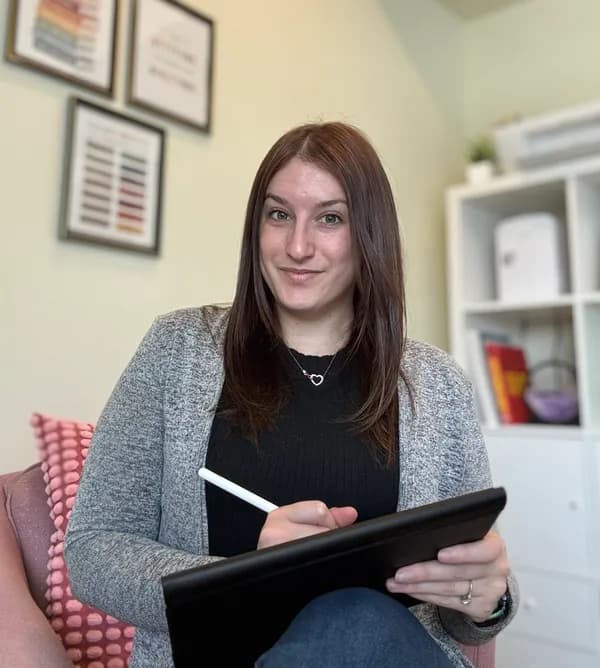Therapy for childhood trauma

The past still affects you. You may feel unsafe, struggle with trust, or carry emotions that appear without warning. These patterns are not your fault. Childhood trauma leaves deep marks, but it can heal. Trauma-focused therapy helps you understand your past and change how it shapes your life today.
Understanding childhood trauma
What constitutes childhood trauma?
Childhood trauma includes any experience that overwhelmed your ability to cope and left you feeling unsafe or alone. This can involve clear harms like abuse, neglect, or witnessing violence, but also emotional abuse, a parent’s addiction or mental illness, relentless bullying, medical trauma, or growing up in chronic fear. What makes an experience traumatic is not only what happened but whether you had support to process it. According to research on adverse childhood experiences (ACEs), the more overwhelming events you faced and the less support you had, the greater the impact on your adult wellbeing.
How childhood trauma affects the developing brain
Trauma in childhood shapes a brain that is still growing. Your threat system becomes overly alert, your stress response stays activated even in safe moments, and parts of the brain involved in emotional regulation may develop differently. Neuroscience research shows that traumatic memories form in fragmented, sensory ways rather than clear narratives, which is why survivors often experience flashbacks, overwhelming emotions, or body reactions even without conscious memory of events.
Childhood trauma in Canada
Sources: Canadian Longitudinal Study on Aging.
How childhood trauma manifests in adult life
Hypervigilance and chronic anxiety
Your nervous system stays on high alert. You scan for danger, startle easily, and struggle to relax even in safe situations. Sleep can feel unsafe because letting your guard down feels risky. The constant worry and dread are not irrational; they reflect a threat system shaped by your early environment and now reacting as though danger is still present.
Flashbacks and intrusive memories
Traumatic memories can surface abruptly, triggered by sensations or moments that echo the past. Flashbacks feel immediate, as if the event is happening again, and your body responds with the same fear. Emotional flashbacks may appear without images, bringing waves of terror or shame that seem to come from nowhere.
Relationship difficulties and attachment issues
Trauma often shapes how you connect with others. You may distrust people, push them away, or repeat harmful patterns from childhood. At the same time, you might cling to relationships out of fear of abandonment. Intimacy can feel frightening because vulnerability once meant danger. Research on attachment and trauma shows these responses began as protection but now complicate adult relationships.
Emotional dysregulation and overwhelming feelings
Emotions can feel unmanageable or unpredictable. You may react intensely to small triggers or feel completely numb. When trauma disrupts early emotional development, you grow up without the tools to understand or regulate strong feelings, so emotions now flood you or shut down entirely.
Dissociation and disconnection
Dissociation creates distance from yourself or the world. Time may feel distorted, your body may feel unfamiliar, or you might feel as though you're watching life from outside. This was a survival response during trauma, but now it appears even when you're safe, leaving you feeling unreal or fragmented.
Shame, self-blame, and negative self-concept
Many survivors carry deep shame and believe they are damaged or unworthy. As a child, it was easier to blame yourself than to see caregivers as unsafe. These beliefs persist into adulthood and create painful isolation, even though the trauma was never your fault.
How therapy heals childhood trauma
Reprocessing the past, reclaiming the present
Trauma therapy does not erase memories, but it changes how your mind and body hold them. Through evidence-based methods, you process traumatic experiences safely so your brain can recognize them as past instead of current danger. You learn to calm your nervous system, challenge beliefs shaped by trauma, and build new patterns that support safety and connection. The aim is not only reducing symptoms but reclaiming your life from trauma’s influence.
The trauma therapy process
Trauma therapy usually follows a phased process beginning with stabilization, where you build safety with your therapist, learn grounding skills, and strengthen emotional regulation before touching traumatic memories. When you are ready, therapy moves into processing, which involves revisiting traumatic experiences in a safe and supported way so your brain can finally store them as past rather than present, allowing emotions that were once overwhelming to be felt and integrated. The final phase focuses on integration and reconnection, where you rebuild a sense of self beyond trauma, practise healthier relationship patterns, and move toward goals that once felt unreachable. Research on trauma recovery shows that this phased approach leads to lasting healing and helps people shift from surviving to thriving.
Evidence-based approaches for childhood trauma
Trauma Focused Cognitive Behavioural Therapy (TF CBT)
TF CBT helps you process traumatic memories while teaching coping and more balanced beliefs. You create a trauma narrative in a structured way that supports integration, and you challenge beliefs such as "I am damaged" or "It was my fault." The model includes relaxation, emotional regulation, and gradual exposure to reminders in safe contexts. TF CBT has strong evidence for reducing PTSD, depression, and anxiety after childhood trauma.
Eye Movement Desensitization and Reprocessing (EMDR)
EMDR uses bilateral stimulation while recalling trauma so the brain can reprocess memories. You identify the memory, the negative belief tied to it, and the positive belief you want. During processing, you focus on the memory while following the therapist’s hand movements or tapping. This activates the brain’s natural healing and stores the memory as something from the past. EMDR is one of the most researched and effective trauma therapies.
Somatic Experiencing and body based approaches
Trauma affects your body as much as your mind. Somatic Experiencing helps you track sensations, notice nervous system shifts, and release trapped survival energy. It is useful for developmental or pre verbal trauma when talking feels too overwhelming. You build tolerance for sensations gradually so your body can return to natural regulation.
Internal Family Systems (IFS)
IFS views you as having parts created to help you survive trauma. Some parts hold pain while others try to protect you from feeling it. IFS helps you access your compassionate core Self so these parts can be healed. It is especially helpful in complex trauma where there were repeated experiences over time. You learn to relate to each part with curiosity and care.
Prolonged Exposure Therapy
Prolonged Exposure helps you safely face trauma memories and avoided situations. Through repeated, guided exposure, your brain learns these memories are not present danger. You recount the trauma in detail while staying grounded, and you approach situations you have avoided. Over time, the memories lose intensity and avoidance decreases.
Dialectical Behaviour Therapy (DBT)
DBT is useful when trauma affected emotional regulation. You learn skills for mindfulness, distress tolerance, emotional regulation, and relationship communication. These skills help you manage intense emotions that are common in survivors of childhood trauma. Many therapists combine DBT skills with trauma processing for a complete approach.
Sensorimotor Psychotherapy
Sensorimotor Psychotherapy integrates body awareness with emotional and cognitive work. You explore how trauma shaped your nervous system and movement patterns and complete defensive responses your body could not finish at the time. This bottom up method helps release stored trauma physically and pairs well with talk therapy.
The healing journey: what to expect
Phase 1: Safety and stabilization (2 to 6 months)
Early therapy focuses on safety in both your life and the therapeutic relationship. Your therapist builds trust slowly, knowing trust may feel risky after childhood harm. You will not be asked to share traumatic details before you are ready. The work centres on ensuring your current environment is safe and on developing grounding, self soothing skills, and emotional regulation. You learn to notice when your nervous system is activated, shut down, or in the window of tolerance. Many people feel relief during this phase simply from understanding their trauma responses.
Phase 2: Processing traumatic memories (6 to 18 months)
Once you are stable, you begin processing trauma in small, manageable steps. The method depends on the approach such as trauma narratives in TF CBT, bilateral stimulation in EMDR, body tracking in somatic work, or parts work in IFS. Distress may rise temporarily as emotions surface, which is normal. Your therapist helps you stay within your window of tolerance while using grounding skills between sessions. Over time, the emotional charge of memories decreases and beliefs formed during trauma begin to shift. Grief, anger, and other emotions may arise as you understand your experiences more fully.
Phase 3: Integration and reconnection (6 to 12 months)
When processing settles, therapy focuses on rebuilding life beyond trauma. You explore identity, values, and what brings you joy. You work on relationships, boundaries, healthy attachment, and trusting yourself again. You may address patterns such as choosing unsafe partners or pushing people away. This phase often includes reconnecting with your body through movement or pleasure and exploring meaning such as creativity, connection, or advocacy. The aim is moving from survival to living and seeing trauma as part of your story rather than the centre of it.
Find a therapist who specializes in childhood trauma
Choosing the right therapist matters. Each province in Canada has its own regulations, which is why working with a recognized professional can make a real difference in your care. Stellocare takes the uncertainty out of the process by listing only verified therapists you can trust.
The right therapist for you
No therapists found with these specialties in Ontario.
Try selecting a different province.Resources and coping strategies for trauma survivors
Canadian community services: Childhood trauma
Adult survivors of childhood abuse (Non-profit)
Cedar Centre (York Region)
A specialized community agency for "Interpersonal Childhood Trauma." They offer a funded therapeutic program called "STAIR" (Skills Training in Affective and Interpersonal Regulation) specifically for adults to build the emotional skills often missed during a traumatic childhood.
Men’s trauma recovery (Charitable)
Men & Healing (Ottawa/Virtual)
A non-profit mental health agency dealing exclusively with men's issues. They run renowned group therapy programs specifically for male survivors of childhood sexual and physical abuse, focusing on anger, emotional integrity, and trauma recovery.
Indigenous healing programs (Government-funded)
Indian Residential Schools Resolution Health Support Program
A federal program ensuring former students and their families (intergenerational trauma) have access to professional mental health counselling and traditional cultural healers (Elders) at no cost.
Women’s trauma counselling
Haven Society (BC) - "Stopping the Violence"
A community program offering free counselling to women whose lives are affected by historical abuse (childhood trauma). They run groups that focus on "Safety & Stabilization"—the first crucial stage of trauma recovery.
Daily practices for managing trauma symptoms
Grounding techniques for flashbacks and dissociation
- 5-4-3-2-1 technique: Name 5 things you see, 4 you can touch, 3 you hear, 2 you smell, 1 you taste. This anchors you in present reality.
- Physical grounding: Press feet firmly into floor, hold ice cubes, splash cold water on face, or do wall push-ups. Physical sensation interrupts dissociation.
- Orientation: Say aloud: "My name is ___. I'm ___ years old. Today is ___. I'm in ___ [location]. I'm safe right now."
- Safe place visualization: Create a detailed mental image of a real or imagined safe place. Practice accessing it regularly, especially when triggered.
Nervous system regulation
- Deep breathing: Breathe in for 4 counts, hold for 4, out for 6. Longer exhales activate your parasympathetic nervous system, promoting calm.
- Progressive muscle relaxation: Systematically tense then release muscle groups from toes to head, releasing held tension.
- Bilateral stimulation: Tap alternating sides of body, cross-crawl movements, or listen to bilateral music (sound alternating left-right). This mimics EMDR's calming effects.
- Vagal nerve stimulation: Humming, singing, gargling, or splashing cold water on face activates the vagus nerve, reducing hyperarousal.
Managing emotional overwhelm
- Container visualization: Imagine placing overwhelming emotions in a secure container. They're not gone, but contained until you're ready to process with support.
- Emotion surfing: Notice emotions like waves—they rise, peak, and fall. Ride them without fighting or feeding them. They will pass.
- Self-compassion breaks: Place hand on heart and say: "This is really hard right now. What I'm feeling makes sense given what I survived. May I be kind to myself."
- Opposite action: When emotions prompt harmful urges, do the opposite. Rage wants you to lash out—go for a run. Fear wants you to hide—reach out to someone safe.
Creating safety in your environment
- Environmental control: Lock doors if that helps, keep lights on, position furniture so you can see entrances, or use white noise to mask triggering sounds.
- Comfort objects: Keep items that provide safety—weighted blanket, stuffed animal, photos of loved ones, or objects from your therapist's office.
- Routine and predictability: Consistent schedules reduce nervous system activation. Your brain learns it can predict what's coming.
- Limit triggers when possible: Avoid news/media depicting violence, limit contact with triggering people, or create distance from reminders during acute healing phases.
Building connection and support
- Identify safe people: Who can you call during crises? Who believes and validates your experiences? Build a specific list.
- Practice micro-connections: Brief, low-stakes interactions (smiling at a barista, chatting with a neighbour) build capacity for connection.
- Support groups: Connecting with other survivors reduces isolation and normalizes your experiences. You're not alone.
- Set boundaries: Protect yourself from people who minimize, blame, or trigger you. Healthy relationships respect your needs and healing process.
Common questions about childhood trauma therapy
Do I need to remember everything that happened to heal?
No. Many survivors have partial memories and still heal. Therapy works with what you recall, your symptoms, and your body’s responses. Approaches like Somatic Experiencing help without detailed narratives. If memories surface, your therapist supports you, but full recall is not required.
Will talking about trauma make it worse?
With trained therapists, trauma work happens at a safe pace and starts with grounding skills. Some discomfort is normal as feelings surface, yet this leads to relief. Avoidance keeps symptoms active. Processing them carefully helps you move forward.
What if I don't trust therapists or feel unsafe in therapy?
Trust takes time. Good therapists expect this and move slowly. You can ask questions, meet several therapists, set boundaries, and take breaks. Their response to your concerns helps you judge fit. You can change therapists if needed.
Can childhood trauma heal if I'm still in contact with my family?
Yes, although it may be harder if family behaviours still trigger you. Many people use boundaries, limited contact, or temporary distance while healing. Your therapist can help you decide what level of contact supports your wellbeing.
Will I ever feel normal or will trauma always define me?
Trauma becomes part of your history, not your identity. With treatment, the past loses its grip and you build a steady, grounded life. Many survivors eventually feel connected and purposeful without being defined by trauma.
What if my trauma "wasn't that bad" compared to others?
Trauma is defined by its impact on you. Emotional neglect, chronic fear, or witnessing harm can be deeply damaging. If you carry symptoms, your experiences were significant. Your pain is valid and worth healing.
Can I heal from childhood trauma without medication?
Many people heal through therapy alone. Medication can help if symptoms like anxiety, depression, or PTSD make therapy difficult. Some use it briefly, others long term. The choice depends on your needs and can be discussed with a trauma informed psychiatrist.
Related concerns
References
- Felitti, V. J., et al. (1998). Relationship of childhood abuse and household dysfunction to many of the leading causes of death in adults. American Journal of Preventive Medicine, 14(4), 245-258. Retrieved from https://pubmed.ncbi.nlm.nih.gov/9635069/
- Teicher, M. H., & Samson, J. A. (2016). Annual Research Review: Enduring neurobiological effects of childhood abuse and neglect. Journal of Child Psychology and Psychiatry, 57(3), 241-266. Retrieved from https://pubmed.ncbi.nlm.nih.gov/26831814/
- Schore, A. N. (2001). Effects of early relational trauma on right brain development, affect regulation, and infant mental health. Infant Mental Health Journal, 22(1-2), 201-269. Retrieved from https://psycnet.apa.org/record/2001-16734-007
- Herman, J. L. (2015). Trauma and Recovery: The Aftermath of Violence. Basic Books.
- Trauma-Focused Cognitive Behavioral Therapy. (2024). About TF-CBT. Retrieved from https://tfcbt.org/
- EMDR International Association. (2024). About EMDR. Retrieved from https://www.emdria.org/
- Somatic Experiencing International. (2024). What is Somatic Experiencing? Retrieved from https://traumahealing.org/
- Internal Family Systems Institute. (2024). About IFS. Retrieved from https://ifs-institute.com/
- van der Kolk, B. (2014). The Body Keeps the Score: Brain, Mind, and Body in the Healing of Trauma. Penguin Books.
- Walker, P. (2013). Complex PTSD: From Surviving to Thriving. CreateSpace Independent Publishing.
- Levine, P. A. (1997). Waking the Tiger: Healing Trauma. North Atlantic Books.
- Perry, B. D., & Winfrey, O. (2021). What Happened to You? Conversations on Trauma, Resilience, and Healing. Flatiron Books.
About Stellocare
Stellocare is a Canadian platform where you can find the best fit therapist for you. Search the right thperaists now by asking our AI, browsing our list, or finding our social workers for personal referral.

Amelia Henriquez
Registered Psychotherapist (Qualifying) (ON)

Melanie Zimerman
Canadian Certified Counsellor

Renée LaJoie
Counselling Therapist (AB)

Emily Hiram
Registered Psychotherapist (ON)

Stefania Bonanno
Registered Social Worker (ON)

Stephanie Neshcov
Registered Psychotherapist (Qualifying) (ON)

Rania Hannawayya
Canadian Certified Counsellor

Shahed Tawfeeq
Registered Psychotherapist (Qualifying) (ON)

Sofia Noreen
Registered Psychotherapist (ON)

Shiny Yang
Occupational Therapist (ON)

Amanda Sanichar
Registered Social Worker (ON)

Devyn Eadie
Registered Psychotherapist (ON)

Yamila Luner
Canadian Certified Counsellor

Supriya Verma
Registered Psychotherapist (Qualifying) (ON)

Jessica Maronski
Registered Psychotherapist (ON)

Anna Evans
Registered Social Worker (ON)

Asta Chan
Registered Social Worker (ON)

Marlo Drago
Registered Social Worker (ON)

Lesley Baker
Licensed Counselling Therapist (NB)

Karen Weishuhn
Registered Psychotherapist (Qualifying) (ON)

Amelia Henriquez
Registered Psychotherapist (Qualifying) (ON)

Melanie Zimerman
Canadian Certified Counsellor

Renée LaJoie
Counselling Therapist (AB)

Emily Hiram
Registered Psychotherapist (ON)

Stefania Bonanno
Registered Social Worker (ON)

Stephanie Neshcov
Registered Psychotherapist (Qualifying) (ON)

Rania Hannawayya
Canadian Certified Counsellor

Shahed Tawfeeq
Registered Psychotherapist (Qualifying) (ON)

Sofia Noreen
Registered Psychotherapist (ON)

Shiny Yang
Occupational Therapist (ON)

Amanda Sanichar
Registered Social Worker (ON)

Devyn Eadie
Registered Psychotherapist (ON)

Yamila Luner
Canadian Certified Counsellor

Supriya Verma
Registered Psychotherapist (Qualifying) (ON)

Jessica Maronski
Registered Psychotherapist (ON)

Anna Evans
Registered Social Worker (ON)

Asta Chan
Registered Social Worker (ON)

Marlo Drago
Registered Social Worker (ON)

Lesley Baker
Licensed Counselling Therapist (NB)

Karen Weishuhn
Registered Psychotherapist (Qualifying) (ON)

